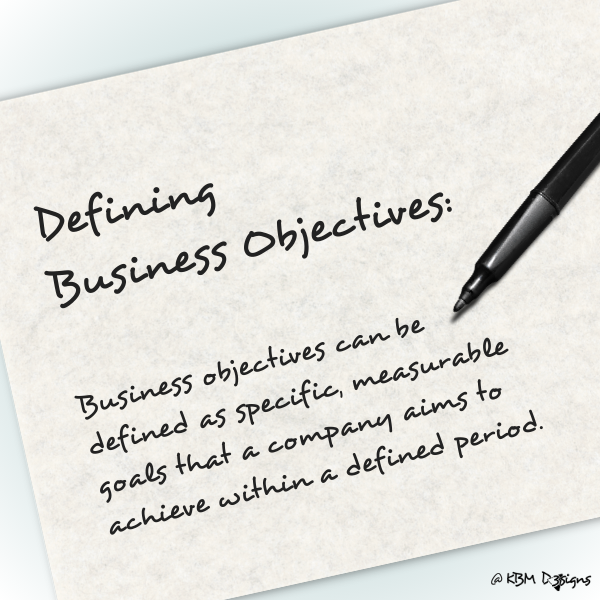What are business objectives? Business objectives serve as guiding principles that help steer the company toward its desired destination amidst the complexities of the marketplace. Small businesses often navigate a myriad of challenges and opportunities in the dynamic landscape of entrepreneurship. At the heart of their journey is one critical element: business objectives. In this article, we delve into the essence of business objectives. We explore their importance and how small businesses can effectively use them to drive growth and success.
Article Content:
Business Objectives: A Guide for Small Businesses

Defining Business Objectives
Business objectives can be defined as specific, measurable goals that a company aims to achieve within a defined period. They provide clarity and direction, outlining the organization’s aspirations and priorities. Whether it’s increasing revenue, expanding market share, or enhancing customer satisfaction, business objectives serve as a roadmap for strategic decision-making and resource allocation.
The Significance of Business Objectives for Small Businesses
For small businesses, establishing clear and achievable objectives is paramount to long-term sustainability and competitiveness. These objectives not only help align the efforts of the team but also provide a framework for evaluating performance and progress. By setting realistic and actionable goals, small businesses can focus their resources effectively, maximize efficiency, and capitalize on growth opportunities.
Key Components of Effective Business Objectives
- Specificity: Business objectives should be clearly defined and unambiguous. Vague or generalized goals can lead to confusion and lack of focus. For example, instead of aiming to “increase sales,” a small business objective could be to “achieve a 20% increase in monthly sales revenue by the end of the fiscal year.”
- Measurability: Objectives should be quantifiable, allowing for easy tracking and assessment of progress. This enables small businesses to gauge their performance objectively and make informed adjustments to their strategies as needed.
- Relevance: Business goals should be aligned with the overall mission and vision of the company. They should reflect the priorities and values of the organization, driving activities that contribute to its long-term success.
- Achievability: While it’s important to aim high, business objectives should also be realistic and attainable within the given resources and constraints. Setting overly ambitious goals can lead to frustration and demotivation, whereas achievable targets inspire confidence and motivation among team members.
- Timeliness: Setting deadlines or time-frames for achieving goals provides a sense of urgency and accountability. It helps prevent procrastination and ensures that efforts are directed towards achieving results within a reasonable time-frame.
Implementing Business Objectives in Small Businesses
- Strategic Planning: Small businesses should engage in strategic planning to identify their objectives and outline the steps required to achieve them. This involves analyzing market trends, assessing competitive landscapes, and identifying opportunities for growth and differentiation.
- Communication and Alignment: It’s essential to communicate business objectives clearly to all stakeholders, including employees, partners, and investors. Ensuring alignment across the organization fosters a sense of purpose and collective effort towards achieving common goals.
- Continuous Monitoring and Evaluation: Small businesses should regularly monitor progress towards their objectives and evaluate their performance against predefined metrics. This allows for timely course corrections and adjustments to strategies based on emerging trends and insights.
- Adaptability and Flexibility: In a dynamic business environment, small businesses must remain adaptable and flexible in their approach to achieving goals. This may involve revising strategies, reallocating resources, or pivoting in response to changing market conditions or unforeseen challenges.
Bottom Line
Business objectives, however, are the foundation of strategic planning and decision making for a SMB. By setting clear, measurable, and achievable goals, small businesses can focus their efforts, maximize efficiency, and drive sustainable growth. By embracing the principles of specificity, measurability, relevance, attainability, and timeliness, small businesses can harness the power of business objectives. And overall, they can overcome challenges, seize opportunities, and thrive in today’s competitive marketplace.
Define Objectives to Focus on
For small businesses, focusing on key objectives that are specific, measurable, achievable, relevant, and time-bound (SMART) is essential for driving growth and success. Here are some possible key objectives to consider:
1. Increase Revenue:
Goal: Increase sales revenue by a certain percentage within a defined time-frame.
Strategy: Implement targeted marketing campaigns, expand product offerings, optimize pricing strategies, and enhance customer retention efforts.
2. Expand Market Reach:
Goal: Enter new markets or expand into existing markets to reach a broader customer base.
Strategy: Conduct market research to identify opportunities, develop partnerships or distribution channels, and invest in targeted advertising and promotional activities.
3. Improve Profitability:
Goal: Enhance profitability by increasing gross margins or reducing operational costs.
Strategy: Streamline business processes, negotiate better supplier contracts, optimize inventory management, and invest in technology to improve efficiency.
4. Enhance Customer Satisfaction:
Goal: Improve customer satisfaction scores or ratings.
Strategy: Enhance product quality, provide exceptional customer service, solicit feedback and act on it, and personalize the customer experience.
5. Boost Brand Awareness:
Goal: Increase brand visibility and recognition in the target market.
Strategy: Invest in branding and marketing efforts, leverage social media platforms, engage in public relations activities, and sponsor relevant events or community initiatives.
6. Strengthen Online Presence:
Goal: Enhance the company’s online presence and digital marketing efforts.
Strategy: Develop a user-friendly website, optimize for search engines (SEO), engage in content marketing, leverage social media platforms, and invest in online advertising.
7. Enhance Product or Service Offerings:
Goal: Innovate and improve existing products or services, or introduce new offerings.
Strategy: Conduct market research to identify customer needs and preferences, invest in product development and research, gather customer feedback, and iterate based on insights.
8. Build a Strong Team:
Goal: Recruit and retain top talent, and foster a positive and productive work culture.
Strategy: Develop competitive compensation and benefits packages, provide opportunities for professional development and growth, promote open communication and collaboration, and recognize and reward employee contributions.
9. Ensure Financial Stability:
Goal: Maintain healthy cash flow, manage expenses effectively, and achieve financial sustainability.
Strategy: Develop and adhere to a budget, monitor financial performance regularly, manage accounts receivable and payable efficiently, and seek financing or investment opportunities if needed.
10. Foster Long-Term Relationships:
Goal: Cultivate long-term relationships with customers, suppliers, and other stakeholders.
Strategy: Prioritize customer retention and loyalty initiatives, establish mutually beneficial partnerships, maintain open communication, and demonstrate integrity and reliability in business dealings.
By focusing on these key objectives, small businesses can establish a clear direction, prioritize resources effectively, and work towards achieving sustainable growth and success in today’s competitive marketplace.
Visit
Zazzle Store
How To Write Business Goals For A Small Business?
Writing effective business goals for a small business involves a structured approach that aligns with the company’s vision, mission, and strategic objectives. Here’s a step-by-step guide to help you craft impactful business goals:
1. Understand Your Vision and Mission:
- Start by revisiting your business’s vision and mission statements. These statements define your organization’s purpose, values, and long-term aspirations.
- Your business goals should directly support and contribute to the realization of your vision and mission.
2. Conduct a SWOT Analysis:
- Perform a comprehensive SWOT (Strengths, Weaknesses, Opportunities, Threats) analysis of your business.
- Identify internal strengths and weaknesses as well as external opportunities and threats that can influence your business’s performance.
3. Set SMART Goals:
- SMART is an acronym for Specific, Measurable, Achievable, Relevant, and Time-bound. Ensure that each goal you set adheres to these criteria:
- Specific: Clearly define what you want to accomplish. Avoid vague objectives.
- Measurable: Establish metrics or key performance indicators (KPIs) to track progress and success.
- Achievable: Set goals that are realistic and attainable given your resources, capabilities, and constraints.
- Relevant: Ensure that your goals align with your business’s overall objectives and strategic priorities.
- Time-bound: Set deadlines or time-frames for achieving each goal to create a sense of urgency and accountability.
4. Prioritize Goals:
- Determine the most critical goals that will have the greatest impact on your business’s success.
- Prioritize goals based on their importance, urgency, and alignment with your strategic priorities.
5. Establish Short-Term and Long-Term Goals:
- Differentiate between short-term goals (achievable within one year or less) and long-term goals (achievable within two to five years or more).
- Short-term goals help you make immediate progress and build momentum, while long-term goals provide direction for sustained growth and development.
6. Align Goals with Functional Areas:
- Consider how each goal relates to different functional areas of your business, such as sales, marketing, operations, finance, and human resources.
- Ensure that goals are integrated across departments to promote cross-functional collaboration and alignment.
7. Write Clear and Concise Goals:
- Express each goal in clear, concise language using action verbs.
- Avoid ambiguity or jargon that may confuse or misinterpret the intended objective.
8. Communicate Goals Effectively:
- Share your business goals with employees, stakeholders, and relevant partners.
- Clearly communicate the rationale behind each goal and how it contributes to the overall success of the business.
9. Monitor Progress and Adjust as Needed:
- Regularly monitor progress towards achieving your goals.
- Evaluate performance against established metrics and make adjustments to strategies or tactics as needed to stay on track.
10. Celebrate Achievements:
- Celebrate milestones and achievements along the way to keep morale high and motivate your team.
- Recognize and reward individuals or teams who contribute to the attainment of business goals.
By following these steps and principles, small businesses can effectively articulate and pursue business goals that drive growth, innovation, and success.
-

How To Design Scannable Business Cards?
Read the post …: How To Design Scannable Business Cards? -

Door Hanger Marketing: A Strategic Tool For Successful Promotions
Read the post …: Door Hanger Marketing: A Strategic Tool For Successful Promotions -

Custom Notebooks With Logo: SMB Essential For Offline Marketing
Read the post …: Custom Notebooks With Logo: SMB Essential For Offline Marketing
Frequently Asked Questions About “What Are Business Objectives?
Business objectives are specific, measurable goals that a company aims to achieve within a defined period. They provide clarity and direction, guiding the organization’s efforts towards desired outcomes.
Business objectives serve as a roadmap for strategic decision-making and resource allocation. They help align the efforts of the team, facilitate performance evaluation, and drive the organization towards its mission and vision.
While mission and vision statements articulate the purpose and long-term aspirations of a company, business objectives are more focused and actionable. Objectives outline specific goals and targets that contribute to the realization of the mission and vision.
Effective business objectives are specific, measurable, achievable, relevant, and time-bound (SMART). They should be clearly defined, quantifiable, realistic, aligned with the organization’s priorities, and have a defined time-frame for achievement.
Formulating business objectives involves identifying key areas of focus, setting specific goals, defining measurable metrics for success, ensuring alignment with the organization’s mission and vision, and establishing a time-frame for achievement.
Yes, business objectives can evolve based on changes in the internal and external business environment, shifts in market dynamics, emerging opportunities or challenges, and the organization’s strategic priorities. It’s important to periodically review and update objectives to stay relevant and responsive to changing circumstances.
Business objectives provide a clear direction for the organization, enabling focused efforts, informed decision-making, and efficient resource allocation. By achieving business objectives, companies can enhance performance, drive growth, and ultimately, achieve long-term success.
Business objectives are integral to strategic planning as they help define the goals and priorities that inform the strategic direction of the organization. They guide the development of strategies, initiatives, and action plans aimed at achieving desired outcomes and fulfilling the organization’s mission and vision.
Clear and well-defined business objectives provide employees with a sense of purpose and direction. They help align individual efforts with organizational goals, fostering a greater sense of ownership, engagement, and motivation among employees as they work towards shared objectives.
Businesses can ensure alignment by regularly communicating business objectives to employees, integrating them into performance management processes, providing resources and support to facilitate goal attainment, and fostering a culture that emphasizes accountability and collaboration across all levels of the organization.
-

How to Make a Brand? – A Guide for Small Businesses
Read the post …: How to Make a Brand? – A Guide for Small Businesses -

How to Choose Brand Colors – A Comprehensive Guide
Read the post …: How to Choose Brand Colors – A Comprehensive Guide -

A Brand Style Guide & A Brand Mood Board & How to Differentiate
Read the post …: A Brand Style Guide & A Brand Mood Board & How to Differentiate


